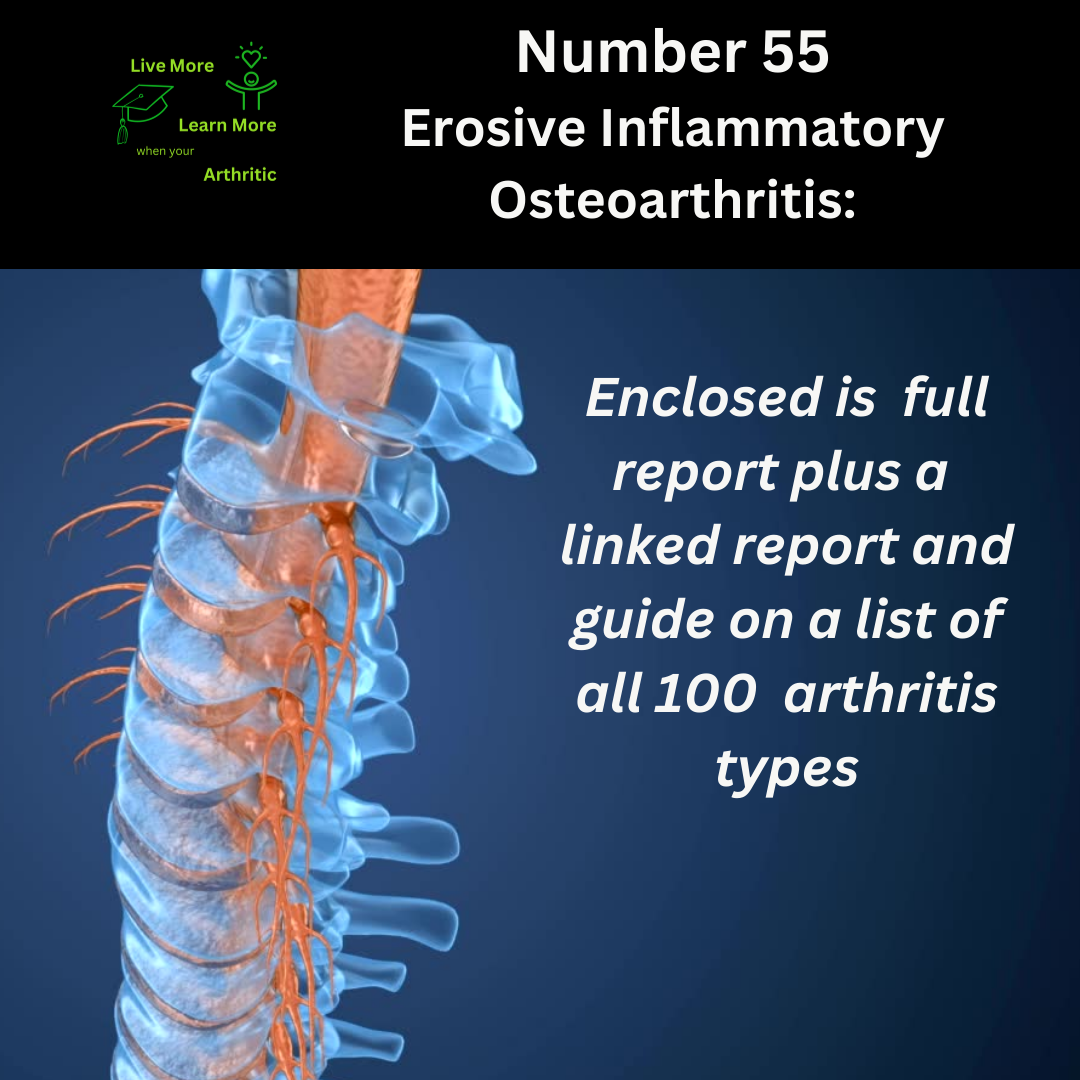
Erosive Inflammatory Osteoarthritis: Number 55 on the list of 100 types of Arthritis
Understanding Erosive Inflammatory Osteoarthritis: A Journey Through Challenges and Hope
In the intricate tapestry of human health, arthritis can be a formidable thread—one that often weaves its way unexpectedly into the lives of many. Among the various forms of arthritis, Erosive Inflammatory Osteoarthritis (EIOA) emerges as a distinctive and challenging condition, its impact often profound yet nuanced.
 What is Erosive Inflammatory Osteoarthritis?
What is Erosive Inflammatory Osteoarthritis?
Erosive Inflammatory Osteoarthritis is a subtype of osteoarthritis (OA) characterized by joint inflammation and erosion of cartilage and bone. Unlike typical OA, which primarily involves mechanical wear and tear of joints, EIOA is distinguished by its inflammatory component, resembling features seen in rheumatoid arthritis (RA).
Description of the Disease:
The hallmark of EIOA lies in its dual nature—melding aspects of traditional osteoarthritis with inflammatory patterns reminiscent of autoimmune disorders. This blend can present a complex clinical picture, often challenging to diagnose and manage effectively.
Enjoy read 6 more articles about Osteoarthritis:
- Osteoarthritis (OA) Self Examination Test
- Osteoarthritis: Number 1 on the list of 100 types of Arthritis
- The six primary symptoms of early signs of osteoarthritis (OA)
- The new dangers of Auto Immune in Osteoarthritis
- Secondary Osteoarthritis: Delving into Causes, Impacts, and Management
- Osteoarthritis care near freedom
Causes and Triggers:
The precise etiology of EIOA remains elusive, though it is believed to stem from a combination of genetic predisposition, environmental factors, and immune dysregulation. Certain triggers such as joint trauma, repetitive stress, or metabolic changes may exacerbate the inflammatory cascade within affected joints.
Symptoms and Limited Range of Motion:
Individuals with EIOA commonly experience joint pain, swelling, warmth, and stiffness, particularly in the hands, knees, and hips. The inflammatory process can lead to erosions of cartilage and bone, contributing to restricted range of motion—a significant source of disability and discomfort.
Age of Onset and Lifespan Impact:
EIOA typically manifests in individuals aged 40 years and older, although it can occur earlier in some cases. Unlike many autoimmune conditions, EIOA is not known to significantly alter lifespan directly; however, the chronic nature of the disease and its impact on mobility can affect overall quality of life.
Autoimmune Nature:
While EIOA shares inflammatory characteristics with autoimmune arthritis like RA, it is not considered a classic autoimmune disorder. Immune system involvement appears to be secondary to joint damage and inflammation rather than a primary autoimmune response.
Proactive Approach for Improved Quality of Life:
A proactive approach can indeed enhance quality of life for those with EIOA. Lifestyle modifications such as maintaining a healthy weight, engaging in regular low-impact exercise, and adopting an anti-inflammatory diet rich in fruits, vegetables, and omega-3 fatty acids can help manage symptoms and preserve joint function.
Possible Complications:
Complications of EIOA may include joint deformity, progressive loss of function, and reduced independence in daily activities. In severe cases, joint replacement surgery may be necessary to restore mobility and alleviate pain.
 Natural Breakthroughs and Health Advantages:
Natural Breakthroughs and Health Advantages:
Research into natural therapies for EIOA is ongoing, with emerging evidence supporting the use of certain supplements like glucosamine, chondroitin, and turmeric for symptom relief. Additionally, mindfulness practices and acupuncture have shown promise in reducing pain and improving overall well-being.
Affected Age Groups and Gender Prevalence:
EIOA primarily affects individuals in their 40s and older, with a slightly higher prevalence in women compared to men. This gender disparity may relate to hormonal influences and genetic predisposition.
Interconnected Diseases and Conditions:
Those diagnosed with EIOA should be aware of associated conditions such as metabolic syndrome, cardiovascular disease, and depression. The inflammatory burden of EIOA can contribute to systemic inflammation, impacting various organ systems beyond the joints.
In conclusion, Erosive Inflammatory Osteoarthritis embodies a complex interplay of joint degeneration and inflammation, presenting unique challenges to those affected. By embracing a proactive approach, leveraging emerging natural therapies, and understanding the broader health implications, individuals with EIOA can strive toward improved quality of life and resilience in the face of adversity.